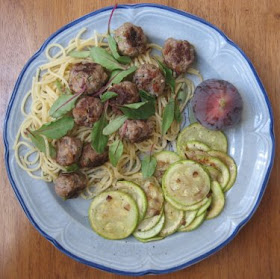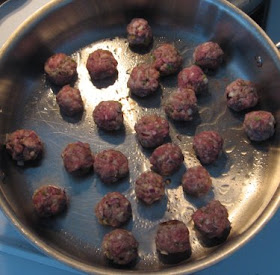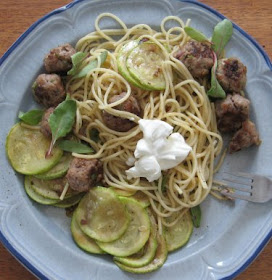
I don't eat a whole lot of meat, as you guys probably are well aware. (That said, this weekend I had a complete and major craving for a big, bloody steak, both cooked and served to me by someone else, and lo, we fulfilled that craving by going to Vive Sol and ordering me a big plate of carne asada. It was delicious.) However, when I went to the Persian market the other day, I decided it was time to try out something from their gigantic halal butcher counter, and so came home with half a pound of meatball-destined ground lamb in my bag.
Ok! These meatballs are totally easy. The only bit requiring any sort of patience is the actual rolling of the meat mixture into balls, which is really not that big a deal at all if 1. you have help or 2. you decide to make big meatballs instead of my tiny inch-in-diameter ones. I personally did not even think it was a big deal to make all kinds of tiny little dudes all by myself. Plus, I had meatballs afterward! It was truly an inspiring moment.
RIGHT.
Lamb meatballsground lamb
breadcrumbs
labneh/plain yogurt
garlic
chili
red onion
salt, pepper
olive oil
For half a pound of lamb, I used probably half a cup of grated stale sourdough, a heaping tablespoonful of labneh, three or four cloves of garlic, a fourth of a big red onion, and I believe just one long green chili pepper of indeterminate origin. They look sort of like cayenne peppers, all long and wrinkly, but the heat is more in line with that of a jalapeño, so I don't know. Of course, that could be because they're green and not their full ripe red, but whatever. Any kind of chili pepper that's to your liking should work fine.
Ok. Get out a big bowl and dump in your lamb. Grate up some stale bread and throw it into the bowl. Finely mince your garlic, chili, and red onion (or yellow or white onion; it's all good) and throw it into the mix as well. Add a spoonful of labneh, season with some salt and pepper, and knead everything together until well mixed. For a totally different meatball, you could add completely different ingredients: lemongrass, lime zest, chopped mint, pine nuts, or even some finely minced apricot, in whatever combination sounds good to you, would all probably turn out some fine meatballs. In my case, I was going straight for the easy choice: the savory, spicy, juicy meatball with few to no complications. This worked out well.

Turn the heat on to medium-hot under a wide frying pan. While the pan is heating, shape the meatballs. I like lots of tiny meatballs, which cook very quickly and have a high proportion of brown crust to meaty insides. If you want to make bigger meatballs, or even lamb burgers, that is fine as well; just adjust your cooking time.
When the pan is good and hot, add a few drops of olive oil and swirl them around to coat the bottom. Set your meatballs in carefully, flattening each one a little for maximum brown crust. Cook until browned, and then turn to brown the other side. The trick to developing a nice crust is not to move the meatballs, so keep yourself under control by washing the dishes or prepping further food; I, for instance, wanted to eat my meatballs in the least traditional spaghetti and meatballs context on the planet, so I heated up a pot of water and cooked some spaghetti at an opportune time. I also cut up some summer squash to sear in the meatball pan aftermath. This worked well.

When everything was done, I tossed the spaghetti with some olive oil, covered it with half of my meatballs and some farmer's market greens, and ate it all with cooked squash and an extra dab of labneh. Since I had both room and figs, I added a fig as well.
This was perhaps the most successful lunch I've had in months.